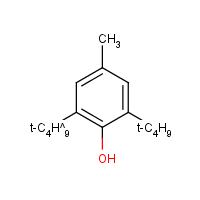Butylated hydroxytoluene
Agent Name
Butylated hydroxytoluene
Alternative Name
2,6-Di-tert-butyl-p-cresol
CAS Number
128-37-0
Formula
C15-H24-O
Major Category
Other Uses

Synonyms
2,6-Di-tert-butyl-p-cresol; Ionol CP-antioxidant; 1-Hydroxy-4-methyl-2,6-di-tert-butylbenzene; 2,6-Bis(1,1-dimethylethyl)-4-methylphenol; 2,6-Di-t-butyl-4-methylphenol; 2,6-Di-t-butyl-p-cresol; 2,6-Di-terc.butyl-p-kresol [Czech]; 2,6-Di-tert-butyl-1-hydroxy-4-methylbenzene; 2,6-Di-tert-butyl-4-cresol; 2,6-Di-tert-butyl-4-hydroxytoluene; 2,6-Di-tert-butyl-4-methylhydroxybenzene; 2,6-Di-tert-butyl-4-methylphenol; 2,6-Di-tert-butyl-p-cresol; 2,6-Di-tert-butyl-p-methylphenol; 3,5-Di-tert-butyl-4-hydroxytoluene; 4-Hydroxy-3,5-di-tert-butyltoluene; 4-Methyl-2,6-di-terc. Butylfenol [Czech]; 4-Methyl-2,6-di-tert-butylphenol; 4-Methyl-2,6-tert-butylphenol; AO 29; AO 4; AO 4K; AOX 4; AOX 4K; Advastab 401; Agidol; Agidol 1; Alkofen BP; Antioxidant 264; Antioxidant 29; Antioxidant 30; Antioxidant 4; Antioxidant 4K; Antioxidant DBPC; Antioxidant KB; Antioxidant MPJ; Antioxidant T 501; Antox QT; Antrancine 8; BAT; BHT; BHT (food grade); BHT 264; BUKS; Butylated hydroxytoluene; Butylated hydroxytoluol; Butylhydroxytoluene; Butylohydroksytoluenu [Polish]; CAO 1; CAO 3; Catalin antioxydant 1; Catalin cao-3; Chemanox 11; DBPC; DBPC (technical grade); Dalpac; Deenax; Di-tert-butyl-p-cresol; Di-tert-butyl-p-cresol (VAN); Di-tert-butyl-p-methylphenol; Dibunol; Dibutylated hydroxytoluene; Impruvol; Ionol; Ionol (antioxidant); Ionol 1; Ionol CP; Ionole; Kerabit; Nocrac 200; Nonox TBC; P 21; P21; Parabar 441; Paranox 441; Phenol, 2,6-bis(1,1-dimethylethyl)-4-methyl-; Stavox; Sumilizer BHT; Sustane; Sustane BHT; Swanox BHT; Tenamen 3; Tenamene 3; Tenox BHT; Tonarol; Topanol; Topanol O; Topanol OC; Toxolan P; Vanlube PC; Vanlube PCX; Vianol; Vulkanox KB; o-Di-tert-butyl-p-methylphenol; [ChemIDplus]
Category
Preservatives
Description
White to pale-yellow, crystalline solid with a slight, phenolic odor; (food preservative); [NIOSH]
Sources/Uses
Used as an anti-oxidant in gasoline, oils, waxes, rubbers, paints, and plastics; purified forms are used as anti-oxidants in foods; [ACGIH] Used as an "anti-skinning agent in paints and inks"; [Merck Index] BHT is a preservative and anti-oxidant used in food, cosmetics, and medications. Industrial applications include: animal feeds, jet fuels, rubber, plastics, paints, and glues. [Marks, p. 138-9]
Comments
Permitted in food at levels up to 200 ppm; Despite its widespread use, BHT is a rare skin sensitizer; Percent positive patch test responses were 0.1% in a US series in 1992-4; Contact urticaria has been reported; [Marks, p. 138-9] May have effects on the liver; [ICSC]
Biomedical References
Exposure Assessment
Skin Designation (ACGIH)
Insufficient data
TLV (ACGIH)
2 mg/m3, inhalable fraction and vapor
MAK
10 mg/m3, inhalable fraction
Vapor Pressure
0.01 mm Hg
Explanatory Notes
Flash point = 260 deg F;
NFPA
must be preheated
Adverse Effects
Skin Sensitizer
Yes
Hepatotoxin
Hepatoxic (a) from occupational exposure (secondary effect) or (b) in animal studies or in humans after ingestion
IARC Carcinogen
Not classifiable
ACGIH Carcinogen
Not Classifiable
Diseases, Processes, and Activities Linked to This Agent
Diseases
Occupational diseases associated with exposure to this agent:
Processes
Industrial Processes with risk of exposure: